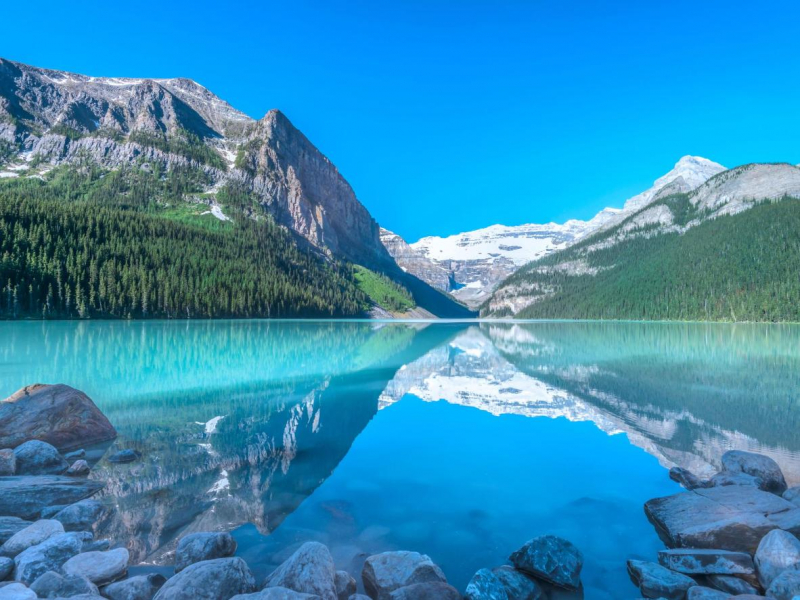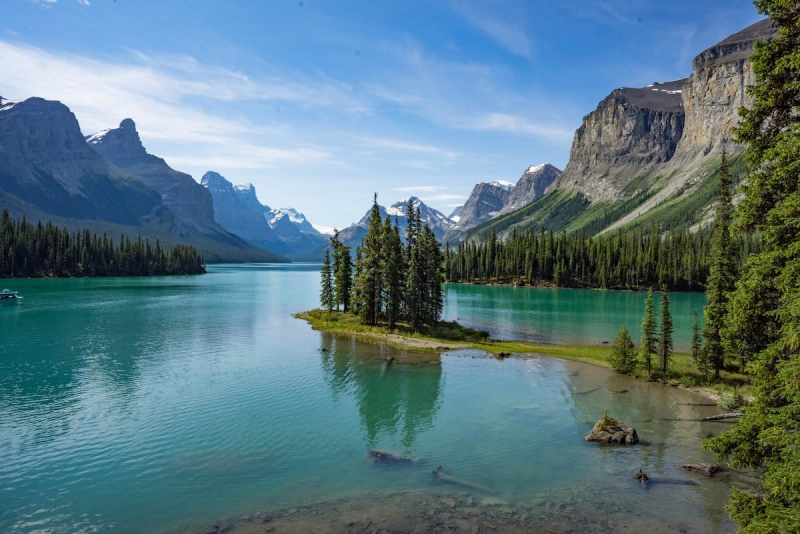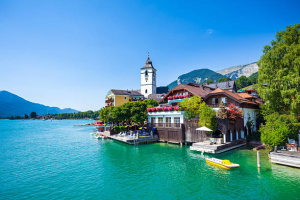Top 12 Most Beautiful Lakes in Canada
Canada is the second largest country in the world by area, and is located at the northernmost tip of North America. So Canada has extremely rich natural ... read more...resources along with countless natural beauties. Those sights have attracted a lot of domestic and international tourists. Let's explore with Toplist the most beautiful lakes in Canada!
-
One of the most beautiful lakes in Canada is Moraine lake. The distance between the village of Lake Louise and Moraine Lake is 14 kilometers. Since the lake is glacier-fed, its spectacular blue-green color is caused by light reflecting off the rock flour (fine rock particles) in the runoff that flows into the lake. The lake doesn't start to melt until June at a height of 1,885 meters, where it is located. Late June is when water levels and color are at their highest.
Around the lake, there are a number of hikes that range from easy strolls to more challenging excursions. The Rockpile Trail is a simple, brief path that follows the rear of the moraine in switchbacks to the top of the natural dam. The landscape that appeared on the back of Canadian twenty-dollar bills printed between 1969 and 1979 is known as the "Twenty Dollar View," and it can be seen from the summit of the mountain.
Cross-country skiers can go on a 15-kilometer thrilling journey to the end of the road and return throughout the winter. Parks Canada creates ski trails that go to the Consolation Valley and Ten Peaks viewpoint. Due to the significant avalanche risk from late November to early April, access to the lake is prohibited during winter.Location: Banff National Park, Alberta

Photo: tripadvisor.com.vn 
Photo: freepik.com -
Adventurers have always flocked to Lake Louise. Every level of adventurer will find something to enjoy here, including sleigh rides, dog sledding, paddling, hiking, and more. For additional information on seasonal activities, visit their Winter in Lake Louise and Summer in Lake Louise sites.
Making Lake Louise your basecamp is a terrific way to experience Banff National Park because there are countless adventures in every direction. The Fairmont Chateau Lake Louise's luxurious accommodations are perfect for anyone who wants to awaken to a view of a lake. Deer Lodge is a historic lodge with various amenities, including a rooftop jacuzzi, that is only a few steps from the lake. Check out Paradise Bungalows, a family-run business that offers private cottages for the entire romantic mountain experience, if you're seeking for a quaint Lake Louise trip. The Mountaineer Lodge and Lake Louise Inn are only two of the lodging choices in the village of Lake Louise. Just outside of Lake Louise, Baker Creek Mountain Resort provides tranquil cabin-style lodging.
Many of the fantastic restaurants in Lake Louise follow the farm-to-table philosophy, pairing the greatest meats from Alberta with the outstanding neighboring growing regions in British Columbia. Try real game meats at Deer Lodge, enjoy a breathtaking view and a fine Okanagan wine at The Fairview Dining Room, or take a gondola ride to The Whitehorn Bistro for delectable cuisine. The Station Restaurant, Laggan's Mountain Bakery, The Lakeview Lounge, Plain of Six Glaciers Teahouse, and The Lake Agnes Tea House are a few additional must-see locations.
Location: Banff National Park, Alberta
Photo: booking.com 
Photo: banfflakelouise.com -
Maligne Lake is situated in Alberta, Canada's Jasper National Park. The lake is well-known for its turquoise water, the surrounding peaks, the three glaciers that can be seen from the lake, and Spirit Island, an islet that is regularly and widely known for being photographed. The lake is reachable by car, including shuttle buses from Jasper, and is situated 44 kilometers south of the town of Jasper. Spirit Island offers boat cruises from spring through fall. The most well-known, longest, and above treeline multi-day hike in Jasper is the 44 km Skyline Trail, which starts at Maligne Lake and ends close to Jasper. The Opal Hills and Bald Hills loops are two other well-liked day walks. Cross-country skiing and snowboarding are winter sports.
Spirit Island in the midst of Maligne Lake is one of the most well-known images of the Canadian Rockies. There is no road or path access to the island, which is 14 kilometers up the lake. The only ways to get to Spirit Island are either tour boats or privately owned, non-motorized vessels.
Both hikers and paddlers can enjoy backcountry adventures in Maligne Valley. There is an adventure waiting for you, whether you choose to paddle to one of the three campsites on the famed 22-kilometer Maligne Lake, hit the trails for a breathtaking trek to Jacques Lake through a small mountain valley, or travel above treeline on the stunning slopes of the Skyline.Location: Jasper National Park, Alberta, Canada

Photo: tripadvisor.com.vn 
Photo: velvetescape.com -
The next position on the list of the most beautiful lakes in Canada is Peyto lake. A glacier-fed lake located in the Canadian Rockies' Banff National Park is called Peyto Lake. The Icefields Parkway is not far from the lake itself. Bill Peyto, a pioneering route blazer and trapper in the Banff region, was honored with his name.
The lake's distinctive bright turquoise color is caused by the significant amounts of glacial rock flour that flow into it from a nearby glacier during the summer. Photos of the lake frequently appear in illustrated books due to its vivid color, and the area around it is a well-liked tourist destination. Parks Canada finished enhancing the lake viewpoint, paths, and parking spaces in 2021. The highest point on the Icefields Parkway, Bow Summit, offers the greatest views of the lake.
Peyto Lake's deep turquoise waters contrast sharply with the mountains that surround it, yet the contrast adds to the beauty of the scene. This lake in Banff National Park is well-known for its vibrant color, which attracts photographers. The greatest location to view this large body of water is from Bow Point on the western Alberta Icefields Parkway. Hikers who want to get a different perspective might go up from there or even down to the lake.
Location: Banff National Park, Canadian Rockies
Photo: wikipedia 
Photo: sworld.co.uk -
Yoho National Park, British Columbia, Canada, is home to Emerald Lake. One of the four contiguous national parks in Canada's Rocky Mountains, Yoho National Park is situated between the provinces of British Columbia and Alberta. The other parks are Kootenay, Jasper, and Banff. These federal reserves also include numerous provincial parks with nearly identical environmental protection and equally magnificent scenery. A luxurious lodge or hotel called Emerald Lake Lodge is situated on a peninsula that projects into the lake.
Tom Wilson, a Canadian guide, accidentally discovered Emerald Lake in 1882, making him the first non-native to see it. He initially arrived in the valley while pursuing a group of his horses that had run off. Wilson was the one who gave the lake its name because of its unusual hue, which reflects the green spectrum of sunlight rather than the blue spectrum seen in the nearby Moraine, Hector, Bow, and Peyto Lakes in Banff National Park due to a different rock type producing the sediment that is suspended in the glacial water.
The largest lake in Yoho National Park in the Canadian Rockies, Emerald Lake, is best visited in July. The emerald green sea is at its most beautiful then. The limestone powder in the lake's water gives it its tint. Waiting until July will allow you to experience the color at its best because the lake is typically iced over until June. However, if you go there in the winter, it's a terrific area to go cross-country skiing.
Location: Yoho National Park, British Columbia, Canada

Photo: tripadvisor.com.vn 
Photo: crmr.com -
Abraham Lake, commonly known as Lake Abraham, is Alberta's largest reservoir and an artificial lake. It is situated on the North Saskatchewan River in western Alberta, Canada, in the "Kootenay Plains portion of the Canadian Rockies' front range".
Abraham Lake is a more recent lake on the North Saskatchewan River in Alberta. Although its waters are glacial blue, it wasn't formed by glaciers; rather, the river was dammed in 1972. The Canadian Rockies are frigid in the winter, but now is a fantastic time to witness the lake's well-known bubble phenomena. Methane released by dying plants causes the water to bubble when it freezes. If you smoke, avoid lighting up close to the ice since methane is flammable.
Abraham Lake's primary draw is during the winter when crystal-like formations are formed beneath the surface of the lake as trapped methane bubbles freeze. Many amateur photographers have been to the area in an effort to capture the breathtaking view because of how beautiful these natural formations are. Abraham Lake is one of the most beautiful lakes in Canada.
Location: Alberta, Canada

Photo: theevolista.com 
Photo: viator.com -
One of North America's five Great Lakes is Lake Ontario. The U.S. state of New York, whose water boundaries along the international border meet in the center of the lake, borders it on the south and east. Ontario, a province in Canada, is its neighbor to the north, west, and southwest.
The northern and western shores of the lake are occupied by the Canadian cities of Toronto, Kingston, Mississauga, and Hamilton, while the southern coast is home to the American city of Rochester. Ontario means "big lake" in the Huron language. The Niagara River, which flows into Lake Erie, is its main inlet. The eastern end of the Saint Lawrence Seaway connects Lake Ontario, the last of the Great Lakes, to the Atlantic Ocean. This exit is made possible by the Saint Lawrence River. The Moses-Saunders Power Dam controls the lake's water level.
Lake Ontario is an ecological marvel because of its size and proximity to the Atlantic Ocean. This lake serves as the conduit for the Great Lakes' entire water supply. Fish move from the ocean to the freshwater lake repeatedly. The lake's various regions offer a variety of environments, including dunes, wetlands, forests, and rocky cliffs.
Location: on the north, west, and southwest by the Canadian province of Ontario, and on the south and east by the U.S. state of New York

Photo: wikipedia 
Photo: istockphoto.com -
The largest of the Great Lakes of North America, Lake Superior is also the world's largest freshwater lake by surface area and the third largest by volume. 10% of the freshwater on the planet's surface is contained there. It is bordered by the Canadian province of Ontario to the north, the American states of Minnesota to the northwest, Wisconsin, and Michigan to the south, and the Canadian province of Ontario to the north.
The magnitude of Lake Superior lessens the intensity of its humid continental climate's seasons. Seasonally varying between 32 and 55 °F circa 1970, the water surface's delayed response to temperature fluctuations helps to regulate the surrounding air temperatures in the summer (cooler with regular sea breeze forms) and winter and causes lake-effect snow in colder months. Particularly in the fall, the lake's bordering hills and mountains act as reservoirs for precipitation and fog.
More than 200 rivers and rivulets flow into Lake Superior, which is home to more than 80 different fish species. The Lake Superior Half Circle Tour, which is the same thing but only conducted on the Canadian side, can be used to visit this area. There are lots of parks, trails, and canoeing options along the road throughout the provincial sections of their tour.
Location: Ontario, Canada
Photo: michigan.org 
Photo: tripadvisor.com.vn -
A turquoise-colored mountain lake called Garibaldi Lake may be found in British Columbia, Canada, 37 kilometers (km) north of Squamish and 19 kilometers (km) south of Whistler. Garibaldi Provincial Park, which has mountains, glaciers, paths, woods, floral displays, meadows, and waterfalls, is where the lake is located. A park is a protected place for animals.
With a surface elevation of around 1,500 meters above sea level and a depth of more than 250 meters, Garibaldi Lake is located in a deep subalpine basin. With the exception of its northwest corner, it is almost fully encircled by mountains. On its north, west, and south sides are volcanoes, and on its northeast and eastern beaches are non-volcanic peaks. Due to the presence of nearby glaciers, the lake is renowned for its vivid blue water. The water's Gatorade-blue hue is a result of the glacial silt or rock flour that flows from the glaciers and remains suspended in the water. The summer months, when there are the sunniest days and the glaciers are melting, are the ideal times to observe this color of blue.
Garibaldi Lake is a breathtaking lake with deep azure color and is encircled by towering mountain peaks and lovely greenery. Bring your camera! You must finish an intermediate-level 18-kilometer round-trip hike to reach the lake.
Location: British Columbia, Canada
Photo: wikipedia 
Photo: tripsavvy.com -
One of North America's five Great Lakes is Lake Huron. In terms of hydrology, it consists of the eastern end of Lake Michigan-Huron, which is joined to Lake Michigan by the 8 km, 37 m long Straits of Mackinac. The Canadian province of Ontario borders it on the north and east, and the American state of Michigan borders it on the south and west. The Huron people who lived in the area were named by early French explorers who gave the lake its name.
Evidence gathered in the Lake Huron region led to the naming of the Huronian glacial. The North Channel and Georgian Bay are located in the lake's northernmost regions. In the southwest part of the lake is Saginaw Bay. The St. Marys River serves as the primary inlet, and the St. Clair River serves as the primary exit.
Recently, a number of new invasive species have been introduced to Lake Huron, including zebra and quagga mussels, the spiny water flea, and round gobies. By 2006, the lake's demersal fish community had collapsed, and the zooplankton community had undergone a number of significant alterations. In recent years, Chinook salmon catches have also significantly decreased, and lake whitefish abundance and health have declined. The new foreign species may be to blame for these recent alterations.
Location: Ontario, Canada

Photo: wikipedia 
Photo: adventures.com -
About five kilometers northeast of the Banff townsite, in the eastern part of Canada's Banff National Park, is a glacier lake called Lake Minnewanka. The lake is the second-longest lake in the Canadian Rockies mountain parks at 21 km long and 142 m deep. The Cascade River, which flows south via Stewart Canyon and pours into the lake's western end, feeds the lake. It flows east of Cascade Mountain. The lake is also fed by a number of streams that descend from Mount Inglismaldie, Mount Girouard, and Mount Peechee on the lake's southern shore.
According to stone tools and a Clovis point spearhead found by archaeologists, Aboriginal people have lived in the area around Lake Minnewanka for a long time—possibly as early as 10,000 years ago. Elk, mule deer, bighorn sheep, and bears are just a few of the abundant wildlife in the area, and the simple access to rock in the rocky terrain made it possible to craft tools for hunting.
Aboriginal people lived near the lakeside following the ice age, and Clovis spearheads have been discovered there. Tourists can take advantage of the cruises that are offered on this lake. Along with other sports, the lakeshore offers fishing, mountain biking, hiking, canoeing, and diving. The area is rich in wildlife, making it a healthy natural vacation destination.
Location: Banff National Park, Canada
Photo: getyourguide.com 
Photo: travelalberta.com -
One of the most beautiful lakes in Canada is lake Athabasca. Between 58° and 60° North in Canada, Lake Athabasca is situated in the northwest corner of Saskatchewan and the northeast corner of Alberta. 74 percent of the lake is in Saskatchewan, and 26 percent is in Alberta.
Since 1926, Lake Athabasca has been used for commercial fishing, with walleye, northern pike, and lake trout making up the majority of the catch. Lake whitefish, arctic grayling, yellow perch, burbot, white sucker, and longnose sucker are some of the other fish species found in the lake.
On a broader scale, the lake is a component of the Peace-Athabasca Delta, a wetland west of the lake that is roughly the size of Prince Edward Island and is biologically diversified. For several bird species, including the whooping crane, whistling swan, as well as different geese, and ducks, it serves as a crucial migration route and a nesting location. In addition, Wood Buffalo National Park, a UNESCO world heritage site and shelter for the biggest wild bison herd in North America, occupies 80% of the delta's land area.
Location: northeastern Alberta and northwestern Saskatchewan

Photo: istockphoto.com Video: https://www.youtube.com/watch?v=ylQMMX7fS9A

































